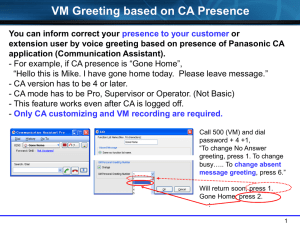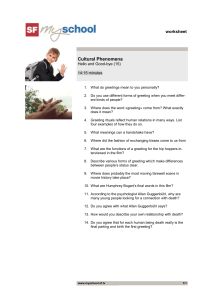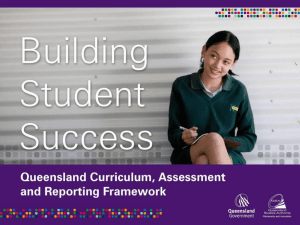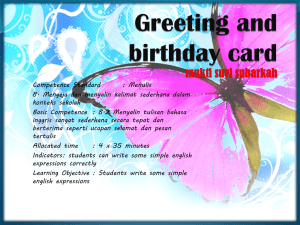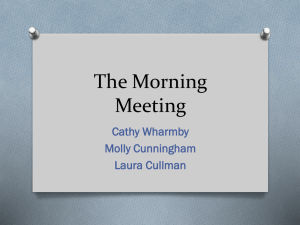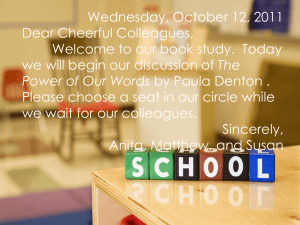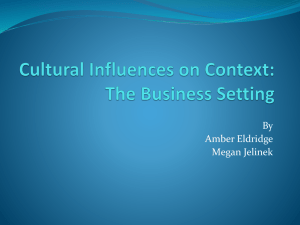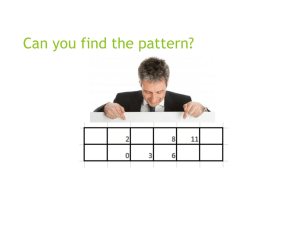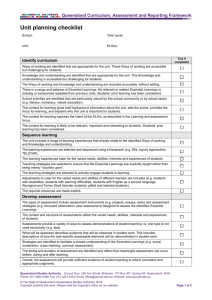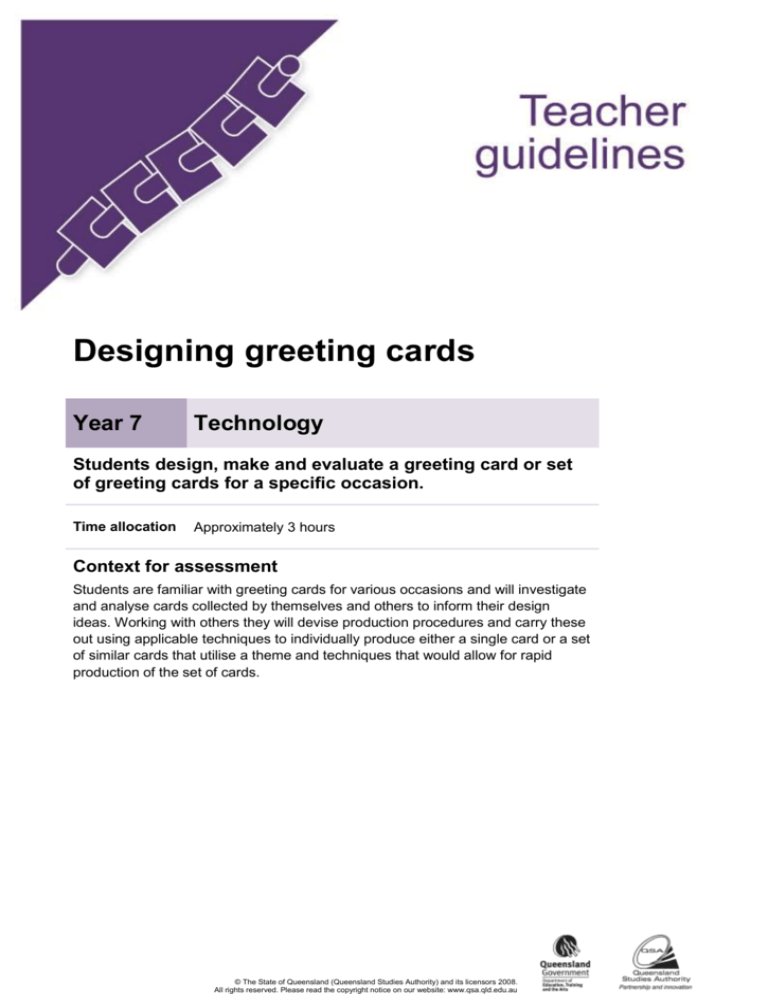
Designing greeting cards
Year 7
Technology
Students design, make and evaluate a greeting card or set
of greeting cards for a specific occasion.
Time allocation
Approximately 3 hours
Context for assessment
Students are familiar with greeting cards for various occasions and will investigate
and analyse cards collected by themselves and others to inform their design
ideas. Working with others they will devise production procedures and carry these
out using applicable techniques to individually produce either a single card or a set
of similar cards that utilise a theme and techniques that would allow for rapid
production of the set of cards.
© The State of Queensland (Queensland Studies Authority) and its licensors 2008.
All rights reserved. Please read the copyright notice on our website: www.qsa.qld.edu.au
Teacher guidelines
This assessment gathers evidence of learning for the following Essential Learnings:
Technology
Essential Learnings by the end of Year 7
Ways of working
Knowledge and understanding
Students are able to:
Technology as a human endeavour
investigate and analyse the purpose,
context, specifications and constraints
for design ideas
Technology influences and impacts on people,
their communities and environments.
generate and evaluate design ideas
and determine suitability based on
purpose, specifications and constraints
communicate the details of designs
showing relative proportion, using
labelled drawings, models and/or
plans
select resources, techniques and tools
to make products that meet
specifications
plan and manage production
procedures and modify as necessary
make products to meet specifications
by manipulating and processing
resources
identify risks and justify and apply safe
practices
evaluate the suitability of products and
processes for the purpose and
context, and recommend
improvements
reflect on learning, apply new
understandings and identify future
applications.
Design and development of products are
influenced by societies’ changing needs and
wants, and include artefacts, systems,
environments and services.
Product design and production decisions are
influenced by specifications, constraints and
aspects of appropriateness including functions,
aesthetics, ethics, culture, available finances
and resources, and sustainability.
Decisions made about the design, development
and use of products can impact positively or
negatively on people, their communities and
environments.
Information, materials and systems (resources)
The characteristics of resources are matched
with tools and techniques to make products to
meet design challenges.
Resources are selected according to their
characteristics, to match requirements of
design challenges and suit the user.
Techniques and tools are selected to
manipulate or process resources to enhance
the quality of products and to match design
ideas, standards and specifications.
Assessable elements
Knowledge and understanding
Investigating and designing
Producing
Evaluating
Reflecting
Source: Queensland Studies Authority 2007, Technology Essential Learnings by the end of Year 7, QSA, Brisbane.
2
Year 7 Technology: Designing greeting cards
Links to other KLAs
This assessment could be expanded to assess the following Essential Learnings:
The Arts — Visual art
Essential Learnings by the end of Year 7
Ways of working
Knowledge and understanding
Students are able to:
Visual Art
select and develop ideas for arts
works, considering intended
audiences and intended purposes,
and make decisions about arts
elements and languages
create and shape arts works by
modifying arts elements to express
purpose and to include influences
from their own and other cultures and
times
modify and polish arts works, using
interpretive and technical skills
present arts works to informal and
formal audiences for intended
purposes, using arts techniques, skills
and processes
identify, apply and justify safe
practices.
Visual Art involves modifying visual arts
elements, concepts, processes and forms (both
2D and 3D) to express ideas, considering
intended audiences and intended purposes,
through images and objects.
Blended, controlled and symbolic colour is used
to create depth, representation and symbolism.
Negative space and positive shape are used to
create abstraction, non-representation and
proportion.
Actual, invented and simulated textures are
used to create depth, representation and nonrepresentation.
Source: Queensland Studies Authority 2007, The Arts Essential Learnings by the end of Year 7, QSA, Brisbane.
3
Teacher guidelines
Listed here are suggested learning experiences for students before attempting this assessment.
Investigate and analyse a variety of cards — topic, size, shape, materials, decorative elements.
Examine the properties of materials and consider techniques to manipulate the materials.
Use tools and equipment e.g. scissors, glue gun, stapler, digital camera, computer program to
develop the product.
Examine the reflection processes — what is reflection, how to reflect, why reflect.
Write text or verse for cards.
Examine the skills of working collaboratively — share design ideas, evaluate these ideas and
the ideas of others for suitability in specific contexts; dividing tasks, decision making, sharing
equipment.
Teacher resources
Desktop publishing is one means of design implementation that students may choose. The
following websites have some useful suggestions and links:
<http://desktoppub.about.com/cs/courses/a/greeting_card.htm> (Accessed 19 May 2008).
<http://blog.illustrationcastle.com/illustrator-resources/greeting-card-design-illustration> (Accessed
20 May 2008).
Preparing
Consider these points before implementing the assessment.
After outlining the design challenge to the students, allow sufficient time for them to make a class
collection of a variety of greeting cards. Teachers may supplement this collection if they wish.
Ensure that sufficient resources including scissors, glue guns, etc, are on hand. Students should
also be encouraged to supply their own materials where possible.
If it is possible for students to use a digital camera then tuition in the use of the camera will need to
be undertaken before the commencement of the assessment or incorporated into the early stages.
Students will consider this and note any prior requirements in their Student booklets. Teachers
should assist in arranging any instruction that is required.
4
Year 7 Technology: Designing greeting cards
Similarly, if students are to use a publishing program then tuition in the use of the program should
be undertaken. It may involve such things as publishing in columns, importing a photograph from
the digital camera, etc.
Risk assessment
Websites for further information include:
Department of Education Manual <http://education.qld.gov.au/corporate/doem>
Workplace Health and Safety Act 1995 <www.dtir.qld.gov.au/hs/hs/htm>.
Note safety considerations:
storage and use of scissors
use of hot glue guns
use of computer and associated equipment.
Implementation
The following implementation process is a suggestion only. Teachers must take into account the
creative processes that students will undertake and not be too prescriptive in setting any particular
method as students create solutions to the design challenge. Students must lead in processes of
investigation, design and production so they can express their own creativity rather than replicate
prescribed and expected outcomes.
Students will produce individual products but in the process consult, discuss and work with other
students and the teacher in making their proposed product. Through this process, alternative
designs, materials and resources may be considered by students. They will also reflect on their
concepts and processes and modify them in the light of responses to consultation.
A further extension to this assessment could be the production of packaging in which to present
the set of cards.
Sample implementation plan
Introductory phase
Activities in this phase are not assessable and focus on:
reading and understanding the design brief
investigating, researching and analysing activities to develop ideas and determine the range of
options available
deciding on the theme of cards — birthday, Easter, Christmas, other occasion
researching from other sources if available
recording valuable ideas.
Teaching considerations
The teacher will explain the design brief in detail to the students. The teacher should organise
research time, guide research and suggest methods of recording ideas so that at the conclusion of
this step students will have a pool of ideas from which to draw. These ideas could be pooled and
recorded in some form such as a wall display to prompt ideas for other students. They could model
ways in which design ideas could be recorded.
5
Teacher guidelines
Developmental phase
Activities in this phase focus on:
generating a number of alternate suggestions including initial, annotated sketches
reflecting on own ideas and the input of others
selecting resources, techniques and tools to make the card/s
selecting the final idea to be developed
identifying production procedures, and formulating and recording a production plan.
Teaching considerations
Brainstorming sessions could be organised to give students the opportunity to interact with others,
to reflect on their ideas and the suggestions of others and adopt or reject additional ideas
suggested. They could ask students questions to prompt them to reflect on their designs and justify
the ways they propose to address the design challenge. Students should consult with the teacher
to show and explain their proposals prior to the production stage. They should provide guidance
and feedback to individual students on the suitability of the verse and processes. A separate
session may be devoted solely to the writing of text to be included in the card. This may be
incorporated as part of the English program. Guidance in the use of specialised equipment such as
a digital camera or publishing program on the computer should also be provided.
Students carry out necessary preliminary steps prior to production that may be necessary such as
taking photographs with a digital camera or scanning images for use on the card/s.
Culminating Phase
Activities in this phase focus on reflecting and evaluating.
Students should be given the opportunity to reflect and express views and opinions on their own
and others’ designs. This evaluation process should also allow them to explain any changes they
made to their initial design. Such reflection should be recorded in their Student booklets.
Teaching considerations
The teacher could model and illustrate how self-evaluation could be undertaken. They may pose
questions to the students to have them explain and justify their choices.
Assessable items
1. Generate a number of possible designs including annotated sketches.
2. Formulate and record a production plan that communicates the main steps in the production of
greeting card/s.
3. Produce the card/s to meet the specifications by selecting, manipulating materials, tools and
techniques as required.
4. Students reflect on the completed project and self-evaluate the completed product and
processes used. They display and explain to others the cards produced and consider the
feedback from others.
6
Year 7 Technology: Designing greeting cards
Resources for the assessment
While not mandatory, emphasis could be given to the production of greeting cards using electronic
means — digital photographs of selected subject matter, publishing programs for the design and
layout of the cards. This may be particularly useful if a student decides to produce a set of cards on
a particular theme where there are minimal design changes between one card and another. Some
students may opt for one-off, hand made artistic designs using a variety of materials.
Teachers may need to supply:
access to a digital camera
access to a publishing program including word processing for the verse or text in the greeting
cards
a variety of glues, glue gun
scissors
paints, brushes
a selection of decorative materials.
7
Teacher guidelines
During the learning process, you and your students should have developed a shared
understanding of the curriculum expectations identified as part of the planning process.
After students have completed the assessment, identify, gather and interpret the information
provided in student responses. Use only the evidence in student responses to make your judgment
about the quality of the student learning. Refer to the following documents to assist you in making
standards-referenced judgments:
Guide to making judgments
Indicative A response
Sample responses (where available).
Making judgments about this assessment
Individual student assessment will involve:
direct observation of the student including their direct participation in any group involvement
analysis of individual designs and production procedures
analysis of a student’s Student booklet
the effectiveness of the final product produced and how closely it addresses the design brief.
For further information, refer to the resource Using a Guide to making judgments,
available in the Resources section of the Assessment Bank website.
Evaluate the information gathered from the assessment to inform teaching and learning strategies.
Involve students in the feedback process. Give students opportunities to ask follow-up questions
and share their learning observations or experiences.
Focus feedback on the student’s personal progress. Emphasise continuous progress relative to
their previous achievement and to the learning expectations — avoid comparing a student with
their classmates.
For further information, refer to the resource Using feedback, available in the
Resources section of the Assessment Bank website.
8

